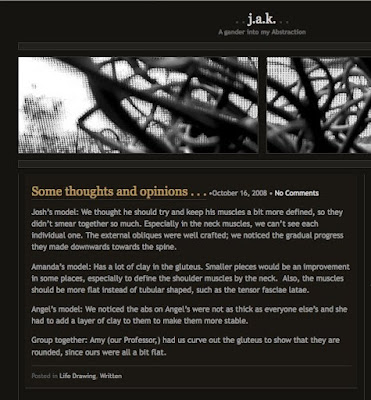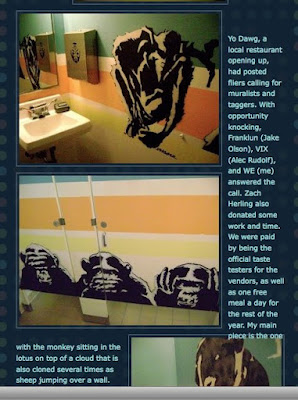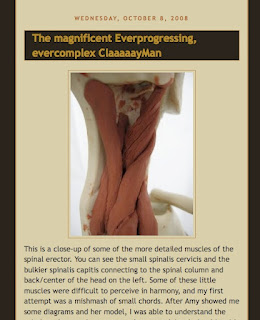
here is another excerpt from
the athlete's way by christopher bergland.
this information deals with purkinje cells, microtubules, muscle memory, and the benefits stretching has on the nervous system (bergland cites these benefits as primary to stretching's benefits for the muscles and tendons)
since we are beginning the work on building muscles and tendons in life drawing one and continuing work on sensing our muscles in yoga, i thought this would be another excellent text to help you understand the relationship between figure drawing and yoga.
also, and just as importantly, this text touches how we learn through repetition, through practice, through creating muscle memories. this applies to the physical process of drawing the figure just as it does to yoga and sporting events. for example, every time you begin a drawing by establishing the long axis of the torso, you are creating a muscle memory. the second time you do this, you strengthen the pathways in your brain that help you do that.
part of my job in life drawing is to assist you in creating new habits for yourself--for understanding the body, for making drawings that have a sense of life, for refining your skill with line.

creating new muscle memories also applies to 1) holding your drawing tool with a drawing grasp rather than a handwriting grasp, 2) standing with enough space between you and your easel, and 3) keeping your eye and hand moving together as you study the form of the figure.
it is also why i have you build the muscles on the maniken. if you can create a muscle memory with your hands and fingers moving from one attachment to the next, you will have access to that memory as you look at the model and remember what that muscle is like as you draw.
this works best when you pay attention to the maniken and clay as you build rather than treating it as busy work while really paying attention to something else while you build. it also means that building a muscle more than once increases your understanding and memory of that muscle--so, if i ask you to re-build a muscle, view it as an opportunity to learn the muscle better.
the excerpt:more from
the athlete’s way: sweat and the biology of blissby christopher bergland
st. martin’s press
new york, ny
2007
*for more information on pukinje cells and microtubules, see below stretch your neurons from head to toede-stress the web of body snatchers
stretch your neurons from head to toede-stress the web of body snatchersthe human body is not a thing of given substance, but a continuous creation. the human body is an energy system . . . which is never a complete structure; never static; is in perpetual inner self-construction and self-destruction; we destroy in order to make new. [norman o. brown, american philosopher]
this chapter is going to focus on flexibility and balance. the athlete’s way is about the process of linking up body, mind, brain, and human spirit. the focus of stretching in this chapter is as much about stretching the cables of your nervous system, improving your state of mind, and getting touch/with your human spirit as it is about the flexibility of muscles and tendons. stretching, and breathing deeply, is a great way to relax and decompress. it gets the kinks out of your nervous system. think of stretching as a way to take a time-out from the hectic world and get yourself centered.
the focus of balance is on the cerebellum and plumping up your
purkinje cells.* balance is a ue-it-or-lose-it system. this chapter will tell you how to practice using your balance system. you want to stretch a little bit every day, and get in the habit of discreetly balancing on one foot throughout the day, in line at the bank or waiting for the bus. (226-227)

stretching engages the network of neurons that is your nervous system and invigorates it--like a massage from the inside out. neurons stretch from the back of your head to the tips of your fingers down your legs to the/ends of your toes. when you bend over to touch your toes you are lengthening axons, elongating
microtubules,* and opening up the synaptic gaps that are the junctions of the billions of neurons woven throughout your entire body. make waking up the nervous system and the benefits on mind, brain, and spirit your number one reason to stretch.
when you stretch your arms as wide as you can, you are elongating the axons that go from the base of your brain to your fingertips. feel the electricity going through each neuron and in the synapses. the circuitry explodes when you stretch, because you are getting the electrochemicals and blood flowing into the nooks and crannies of the nervous system, which wakes it up. breathe deeply and imagine sending oxygen and blood flow to those areas that feel tight.
neurons need the nutrients delivered by blood flow and oxygen that stretching sends there. visualize this when you stretch. imagine every breath sending more blood flow and oxygen to the tight area. feel the stretch as you hold it and breathe. imagine that you are flooding that area with fresh nutrients and washing away the old stale toxins. this is a simple visualization that has worked for me every day for twenty years.
your brain alone has enough energy to light a twenty-watt lightbulb, but there is much more energy than that in your entire nervous system. your ability to tap the collective pool of energy in the universe is infinite. imagine the kilowatts pumping through your nervous system and plug into it. light up your spinal column. (228)
 microtubulestransport tubes of bliss molecules
microtubulestransport tubes of bliss moleculesover time, with continuous daily practice, exercise strengthens--plumps up--the microtubules to transport more effectively the neurochemicals associated with bliss. the improved delivery system can result in more amplified feelings of bliss because the pipes run faster and cleaner.
these waterproof pipelines can transport a substance from the body of a cell to its synapse end-terminal up to three feet away. inside each axon are about a hundred microtubules that lie flaccid like a flat fire hose. with a neurotransmitter cargo inside, they become rigid and stiff. these pipelines will swell within 1/10,000 of a second when a neuron springs to life and begins to communicate using the chemicals pumped through millions of neurons like wildfire, each linking at the tips of these microscopic channels to create an engram, a neural net. within each axon, there are actually a hundred separate delivery systems squirting messages into the synaptic gap in milliseconds. this is how all the neurotransmitters transport chemical messages and deliver cargo to pleasure and pain centers.
when you exercise, microtubules pump serotonin into the frontal lobes--this makes you happier and smarter. researchers at johns hopkins have recently discovered that the strengthening of axons in the frontal cor-/tex because of more serotonin is probably what makes SSRIs (selective serotonin reuptake inhibitors) like prozac work. although it is too early to say, the real power in antidepressants may actually lie in the microtubules becoming a better delivery system because of serotonin, which also occurs with exercise.
breaking a sweat makes your microtubules bigger, stronger, and more efficient. my dad says, “people like you and lance armstrong who do a lot of exercise have bigger microtubules than the rest of us.” you need microtubules to be able to deliver large quantities of cargo quickly. they get stronger and bigger when you overload them. this cutting-edge concept is just beginning to be studies by other neuroscientist. (118-119)
 purkinje cellsthe key to muscle memorylearn by practice. --martha graham
purkinje cellsthe key to muscle memorylearn by practice. --martha grahamnumber of purkinje cells = 15 to 25 million (relatively small number)
number of synapses made on a purkinje cell = up to 200,000 (relatively huge number)
muscle memory is stored in the purkinje cells of the cerebellum. purkinje cells are named after johannes purkinje, who first identified these neurons in 1837. dr. purkinje was also the first person to identify the individuality of the human fingerprint. he had a figt for discovering relatively obvious things everyone else had overlooked. purkinje cells are the most distinctive neurons in the brain; their dendrites fan out into chinese fans. dendrites are arranged at right angles to the parallel fibers other molecular layers, forming tens of millions of synapses. but they never touch.
you could think of one thousand purkinje cell dendrites as a “receiving dish” from many wide and varied places in your body. the single pukinje cell axon could be seen as one outgoing wire sending signals from all over the place through a consolidated pipeline. the dendrites of purkinje cells are parallel but never touch. they oscillate like fishtails and push signals up the axon, out of the cerebellum, and up into the cerebrum. the power of these “fishtails” oscillating in unison could also be seen as a car engine with thousands of cylinders (the dendrites) channeling information into a single drive shaft (the axon).

the synaptic plasticity of purkinje cells is in your hands. they are reshaped daily through practice and repetition. the purkinje cells work at a quantum speed. the amplification of more than two hundred thousand incoming signals through one axon offers parallel processing capability from the cerebellum up into the cerebrum.
this lightning-fast processing in a goalie’s cerebellum allows him to leap for a soccer ball while reaching out his hands, keeping his eyes locked on the target. his cerebellum monitors postural control, muscle tensions, velocity, and gravity before he grabs the ball and rolls as he hits the grass. the final output of any given purkinje cell is via a single axon, but all the purkinje cells are working autonomously, but simultaneously. they oscillate together and march in lockstep. these cells take sensory information from all parts of the body and send it to the cerebrum. (119-120)
 the dates and times of our final meeting(s) are listed to the left on the sidebar.
the dates and times of our final meeting(s) are listed to the left on the sidebar. this post should include: 1) 5-6 of your best drawings since your october class summary (self-portrait, at least one skull, and 1-2 other long poses and 2-3 gesture drawings); 2) one or two paragraphs summarizing your experience in Life Drawing I including what two-three most substantial things you learned or at which you improved, citing examples; 3) a description of your experience building muscles on the maniken (photos optional).
this post should include: 1) 5-6 of your best drawings since your october class summary (self-portrait, at least one skull, and 1-2 other long poses and 2-3 gesture drawings); 2) one or two paragraphs summarizing your experience in Life Drawing I including what two-three most substantial things you learned or at which you improved, citing examples; 3) a description of your experience building muscles on the maniken (photos optional).
draw a self-portrait (18" x 24") using what you learned about the structure of the skull and facial features. draw yourself from a front 3/4 view, using a mirror. construct the drawing with line and line value only, not with shading. your focus should be on planar analysis, anatomical landmarks, cross-contours, and line quality--as well as acute observation of your own particular skull and face.















































